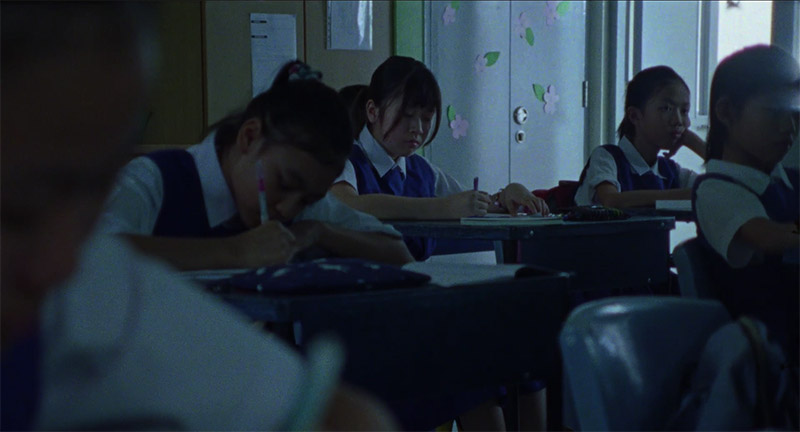
The period of time between coming-of-age and the end of an age is long, but the experience of either is perhaps not that different at all. Between Cheryl Wong’s Stigma, Style (2021) and Giselle Lin’s Time Flows in Strange Ways on Sundays (2021), we find that to grow and to stumble is a process that never ends; acceptance and memory take centre stage here, imbuing in these shorts a sense of universality as they explore the weight of connections between people.
Reviewed by: Goh Yu Ke
Stigma, Style (2021)Wong’s film is, most compellingly, an honest portrait of being young, awkward, and curious. The depiction of eleven-year-old Kerri is always handled with care, but also in a gently ribbing, self-aware manner: the film opens with her attempting a DIY hair removal with scotch tape, a nod and wink towards the unwieldiness of puberty that is endearingly relatable. Pair that with a car ride full of her brothers, annoyingly obtuse and occasionally crass, and we have truly stepped into her world.
School seems to provide little respite; Kerri and her friends sit in dark classrooms, passing notes while their teacher’s biology lecture provides a droning backdrop to their plans for an afternoon at her friend Jess’ (the lesson on the reproductive systems of flowers, notably, is where we get the film’s title from). Even amongst girlfriends, however, Kerri is a little out of place. She forgets her swimsuit and resigns herself to watching them play from the pool’s edge. As the girls walk towards Jess’ place, Kerri stays outside of their conversation about celebrity heartthrobs, instead enquiring after Jess’s older sister Clara—the centre of the film’s allure. Even as she finally finds herself a swimsuit, Kerri’s ill at ease, ducking underwater to escape her friends’ games and eventually indoors, calling her father to pick her up early. The frustrations of adolescence feel total and complete. 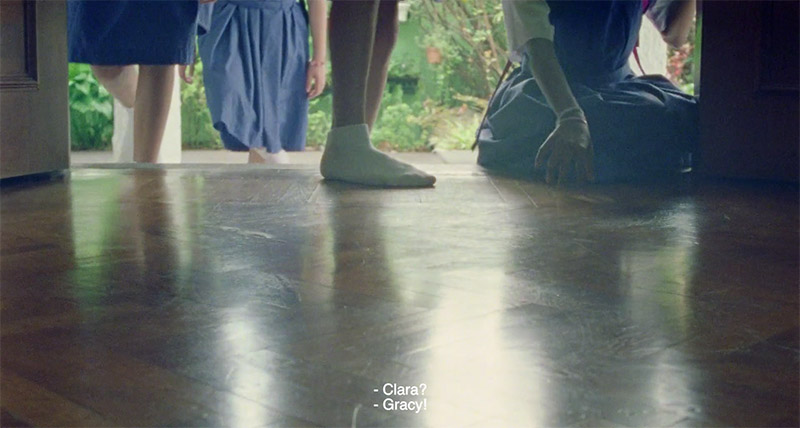 Still From Stigma, Style (2021, Dir. Cheryl Wong Ye Han) Between the bothersome brothers, stifling school life, and the feeling of isolation from her friends, Kerri, and the audience along with her, begin to itch for something more; to find a sense of connection in a world where nobody seems to understand you. The film dedicates a good chunk of its 13-minute runtime to establishing the sensations of being young and misunderstood, and the discomfort of navigating a world in this mode; but it’s precisely such deep attention to detail that makes its payoff of acceptance so effective. From the uniform blouses buttoned all the way up to the ground-level shots of the girls’ entry into Jess’ house, Wong recreates the cumbersome process of growing into oneself, while setting up the space for the relationship between Kerri and Clara to grow in its significance.
It is a relief, then, when we slip naturally, welcomingly, into a scene in the kitchen with just Clara. Clara asks no questions, and instead invites Kerri to help her with her cookies, readily offering advice and approval. The younger girl’s curiosity and reverence are palpable; the camera translates this through close, low-angled grazing shots as she examines her. In the bathroom after this encounter, Kerri borrows a razor—presumably Clara’s—and shaves under her arms. 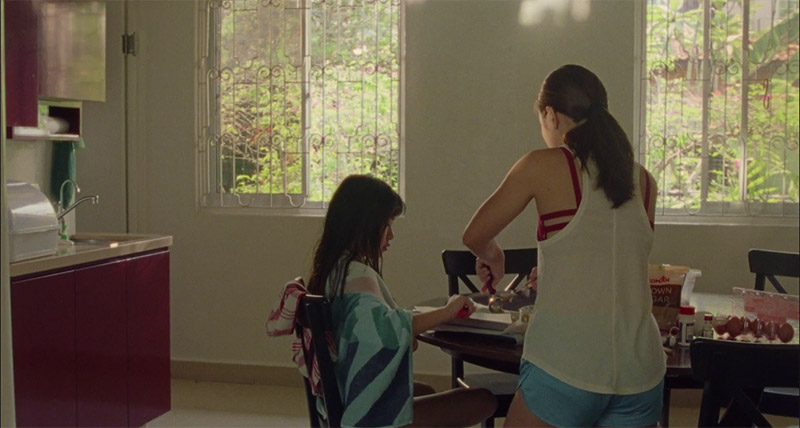 Still From Stigma, Style (2021, Dir. Cheryl Wong Ye Han) 1 What Stigma, Style does is not only portray the power and euphoria of being truly seen, but also the struggle of finding such acceptance in girlhood. Clara is, if nothing else, a role model, a presence that guides Kerri through the first strange steps of her growing femininity. We are invited to find, along with Kerri, these moments of connection for the necessary support and affirmation in order to continue on.
It would be a disservice, however, to gloss over the queer undertones of the film. Kerri’s feelings of estrangement amongst her friends, especially amidst their spirited discussions of male celebrities, can very well be understood as queer alienation, even if Kerri herself does not quite yet have the words for it. In the tender, glazy wonder through which she watches Clara, we see inklings of an adolescent crush, enacted awkwardly, with a childlike need for concrete possession, in the theft of her bra. But therein lies the strength of Wong’s film: it is ultimately a story of love and connections, of processing it in the strange ways we find ourselves capable of. It’s a sentiment that transcends the specifics of any situation, and what makes Stigma, Style a thoughtful watch.
Time Flows in Strange Ways on Sundays (2021)Where Wong’s film brings us back to beginnings, Lin takes us through the experience of an end. Confronted by the impending wedding of her late son’s childhood sweetheart, a mother finds herself paralysed. In many ways, the film feels more like a montage, snapshots of moments in her process of mourning. We are taken to the seaside, where she ponders the waves, cast in blue light; we watch her at church, distracted by her son’s old sweetheart with her fiancé; at home, she sits in silence as she receives their wedding invitation.
As with Stigma, Style, Time Flows in Strange Ways on Sundays gestures towards the difficulty of moving ahead in a world that seems to offer no assistance, only resistance. There is a striking sense of stillness in this montage; between the static framing of the camera and the movement of the people and places around her, the mother is at once a focal, unmoving point and a sore thumb in a world that is raring to move on. Out of place and stuck in time, her discomforting process of mourning is allowed to simply exist within a cinematic space—a first step towards the diegetic recognition and acceptance of her grief that is to come, as well as a lovely nod towards the importance of film as a medium of connection. 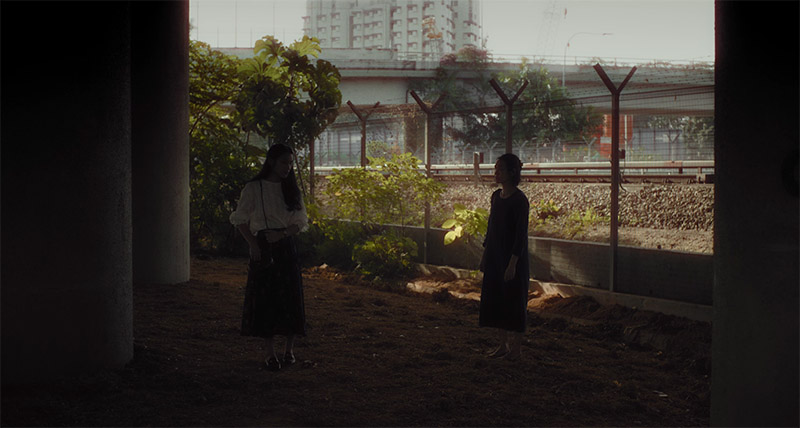 Image Still From Time Flows In Strange Ways On Sundays (2021, Dir. Gisele Lin) To this writer, the film has yet to reach its full narrative potential in such scenes, falling just short of matching up to its stunning composition. This, in turn, influences the extent of the actors’ performances; the mother’s stillness, for instance, asks of its audience to assign meaning to it, rather than signalling a depth that we are invited to uncover. The rich visual language of this short is, however, undeniable. The mother’s paralysis is well reflected—she lingers in doorways, between archways and pillars, the thresholds of places. A climactic moment between her and the ex-girlfriend takes place under and beside train tracks, a no-man’s-land, a place in between the movement and moving-on that she can’t quite achieve yet. It’s an intelligent mode of introspection that prompts us to consider how the spaces in our lives form our emotional processes.
Even as the experience of a death feels arresting and moving on feels inconceivable—and, perhaps, inconsiderate—the mother does, in time. It’s a slow, meandering movement that we follow, in the scene where the father comes to his wife at the beachfront to guide her back from the edge of the shore. The walk back to land is not consistent, but rather starts and stops at points; it is the father’s spoken acknowledgement of his wife’s grief, and the promise to remember their son, that restarts her steps. In its montage-like fashion, the film wraps its affirmation of the importance of human connection and support up in this scene, literally visualising how it moves us onto a path out of stasis and confusion. 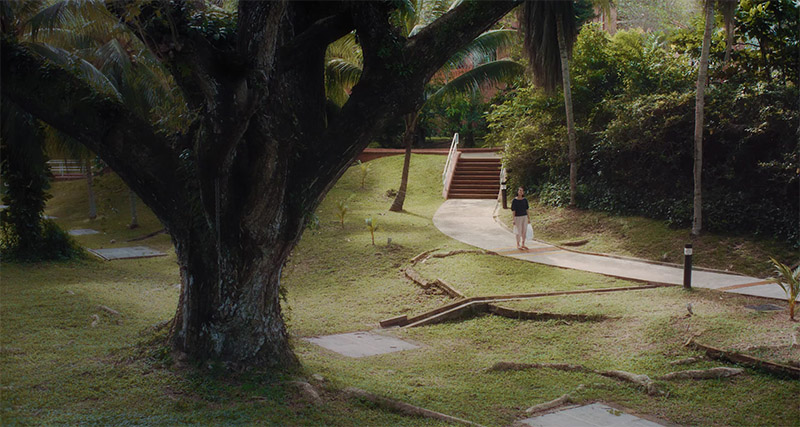 Image Still From Time Flows In Strange Ways On Sundays (2021, Dir. Gisele Lin) 2 This movement is a quiet shift that the film further portrays through light, shifting from the shadowy mode that dominates the first half to a shot of the bright outdoor sky; we look upwards at a tree moving in the wind, a neat parallel to the waves we looked down at in the beginning. There, the mother stands, bathed in the open light of day. The simplicity of this change belies the argument that acceptance and understanding, even in our hiccups and moments of fallibility, is irreplaceably significant. The audience’s willingness to view and follow this mother’s process is, even further, yet another form of co-optive connection that strengthens this point. Connection, in all its forms—between a girl and her friend’s sister, a mother and a father, or even an audience and a character— can change us for the better.
Indeed, it is through the building up of small moments, such as those illustrated in both Stigma, Style and Time Flows in Strange Ways on Sundays, that big changes are wrought. What these two shorts have done is to illustrate the possibility of such changes in small moments of time, to loop their audiences into their role in encouraging such changes, and to point us towards places where we may find the courage to stumble on. _ Goh Yu Ke is an English Literature and Film Studies student at the National University of Singapore. At present, her interests in literature and film revolve around the Asian diaspora and the poetics of space. When she’s not reading or busy being a student, you can find her working through her watchlist of 1940s screwball comedies. |
Click Here For More Film Reviews
Do you love writing? Send us a film review and we will feature it on our website. Any film that people can see in the theater or online. Email to: media@scape.sg
This review is also published on Asian Film Archive as part of *SCAPE’s Film Critics Lab: A Writing Mentorship Programme.

